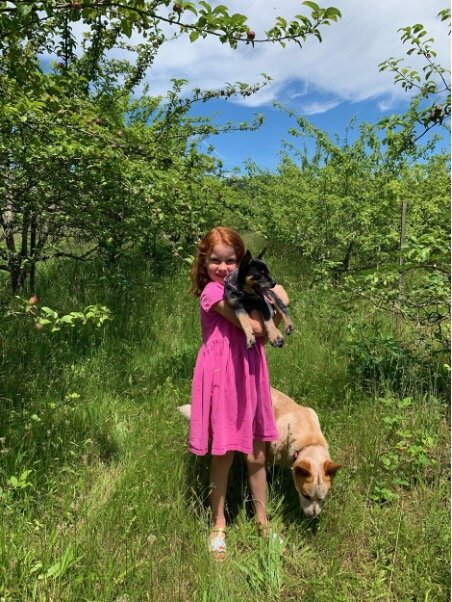Trial By Fire
I remember it like it was yesterday. Waking up to smoke in a drafty cabin on Labor Day. The air was thick and the sun a hazy pink flare, like a small moon. Knowing at some point that I needed to drop in on the Walter Scott family, it seemed as good a time as any to take the two-hour trek southwest from the Columbia Gorge to bluebird skies in the Eola Amity Hills.
Unbeknownst to us a northern cold front so violent had moved into Colorado; it replaced highs in the 80’s with snow in a 24-hour turnaround. The heavy cold air, pushing out the warmth like a tsunami, sent torrents of high winds out west. Lightning strikes from thunderstorms the month prior saw small fires merge near Jawbone Flats before finding the Santiam Pass. Downed power lines from 50-65 mph wind gusts ignited 13 spot fires which accelerated the blaze into a nightmare scenario. At some stretches the flames roared through the canyon at a clip of 500ft per second, before threatening Salem some 60+ miles away and eventually Portland.
By early afternoon, while Lucy was playing with her father in their makeshift pool, and over by the vegetable garden, Copper, Juniper and Bob, the four-legged family members, were teasing chickens in the coop (as they do), we all looked east toward the hills. There in the distance, a typical view of Mt Jefferson was washed out by a descending smoke cloud. By early evening, it had reached the winery; the sky above us like something out of a Phillip K. Dick novel, as this lovely idyllic home, just moments ago a postcard, found itself shrouded under a Mars-like amber veil. And there the veil sat in stillness over the Willamette Valley, for several days leading up and through harvest.
For all that we don’t know about smoke-tainted grapes, it was hard to imagine worse timing for the bulk of west coast wineries, including those in California, who escape mention in this article. Pinot Noir, like other thin-skinned varieties fared the worst. Chardonnay’s impact was top to bottom less severe due to its thicker skins and immediate pressing/release of juice for fermentation.
It just so happened that Ken, Erica and Lucy decided for the first time to harvest cider apples that the Casteel Family planted in Justice Vineyard. In addition they foraged wild trees along the road to Temperance Hill. Apples, possessing a heartier shell, seemed to show no effect at all from the smoke; we happily received similar reports from James Mantone of Syncline with his foraged cider between Lyle and Trout Lake, as well as Hiyu, with their high-elevation orchard source near Mt. Hood (the higher elevation sites in the Gorge were hit hardest by smoke taint).
Ken and Lucy amongst the apples in the Justice Vineyard
And so, in their inaugural effort at cider making, Walter Scott barreled down a gorgeous apple wine that overwintered, gaining complexity as blades of green growth pushed through the scorched earth in 2021. Ken and I retasted the cider and every Chardonnay in the cellar a few weeks ago (Walter Scott did not ferment any Pinot Noir in 2020). Despite labs revealing smoke taint in some of their Chardonnay barrels, the perceptible effects were subliminal to non-existent.
With apple juice still ripping through fermentation, we decided to entertain the idea of a quasi-co-ferment of untainted white wine, trialing many a salt-kissed barrel, before assembling a 50/50 blend of Koosah Vineyard Chardonnay in tank with the cider as of early May.
So begins the fruit wine revolution of Walter Scott, whereby flora other than grape provides an insurance policy to future growing seasons. But Ken & Erica are slow to hang on their story and quick to empathize with the 500,000 evacuees across the state, fortunate enough to escape the hellfire that bore down on them while we all slept peacefully in our beds.
The day before we created our apple-grape wine, the Walter Scott family took me morel foraging in the Santiam Pass. Morels are known to flourish in burn zones from the previous season, offering us a bird’s eye view of 400,000 scorched acres on the drive in. We left with an empty bag and a full heart as the wildfire that tore through 4 counties left a wake of charred firs, pines and leveled homes through mile after mile of river canyon.
To pass by entire towns along the OR-22, reduced to rubble in one summer night—to see empty square foundations where post offices and motels and churches used to stand, communities like Detroit and Gates. OR, still wiped clean, as if a giant child had toppled a Lego city—it was a sobering reminder of how fortunate we are to be gifted another lap around the sun, under roof and four walls.
When we realize that the business of expectation is a relative enterprise, we’re more likely to surrender smaller sidebars of industry impact for the deeper narrative. We can talk until were blue in the face about vineyard woes, what pickers endured harvesting fruit under an orange sky, and the varied and delicate approaches to a commodity marked by smoke, but no one would dare play their violin in front of Chris Tofte or Angela Mosso or Scott Torgeson or any resident of Santiam Canyon or the hardest hit towns of Southern Oregon.
Only the sign remains in front of the Detroit Community Church.
Phoenix, Oregon.
Fire retardant stains the ruins of Talent, Oregon red.
Of the over 1 million acres in Oregon that burned in 2020, at least 4 of the fires were human-caused. But when you peer into the numbers, average acreage burned in the last 15 years is more than double the prior 15, rendering human-induced climate change a foregone conclusion in the frequency, intensity and duration of the modern fire season. 4009 homes were lost in 2020, including 264 homes in Detroit alone, which is roughly their entire population; not to mention 2800 structures between Ashland, Talent and Phoenix.
Meanwhile, the pandemic has launched a diaspora of urban ‘outfill’ into rural regions. Construction has proliferated at such a rate that lumber is 3 times the price it was a year ago. Rising timber prices incite more logging interest. More logging exacerbates desertification—the primary cause of warm, dry conditions that make wildfires more destructive, more often. As structures lost to blaze increase, it fuels the need for more construction and the vicious cycle becomes a feedback loop that sees the Weyerhaeusers of the world laughing all the way to the bank.
As I pen this article, we hold our breath, heading into summer in the driest Oregon water year since 1956. And I could continue painting the tired motif of doom and gloom, oversimplifying the highly sophisticated mess we’ve made, trying to tease out where all the fingers ought to be pointed, but instead I look to a family winery in the eye of the storm, who each season, lives a little leaner, sinking a little deeper into the feral tapestry about them. While others explore the time-honored tradition of ‘more’, Ken & Erica ask ‘What can we part with?’ that might obstruct their bond with the land and free them up to participate in the harmony it draws them toward. A deepening intimacy informs the sensitivity of their practices to the degree that it proves difficult to find the line between how one goes about their work and their play.
It is in this primitive and soul-quenching space, whereby a new feedback loop emerges. One, that is self-aware enough to realize that in the rebuilding process, any new construction must first drive hammer and nail through our relationship with the natural world. Such a restoration begins at the cellular level, and testifies in seasons to come, that if anything must burn down, let it be the false partition that fools us into believing we’re separate.











